The AMD Radeon R9 Fury Review, Feat. Sapphire & ASUS
by Ryan Smith on July 10, 2015 9:00 AM ESTCompute
Shifting gears, we have our look at compute performance. As compute performance will be more significantly impacted by the reduction in CUs than most other tests, we’re expecting the performance hit for the R9 Fury relative to the R9 Fury X to be more significant here than under our gaming tests.
Starting us off for our look at compute is LuxMark3.0, the latest version of the official benchmark of LuxRender 2.0. LuxRender’s GPU-accelerated rendering mode is an OpenCL based ray tracer that forms a part of the larger LuxRender suite. Ray tracing has become a stronghold for GPUs in recent years as ray tracing maps well to GPU pipelines, allowing artists to render scenes much more quickly than with CPUs alone.
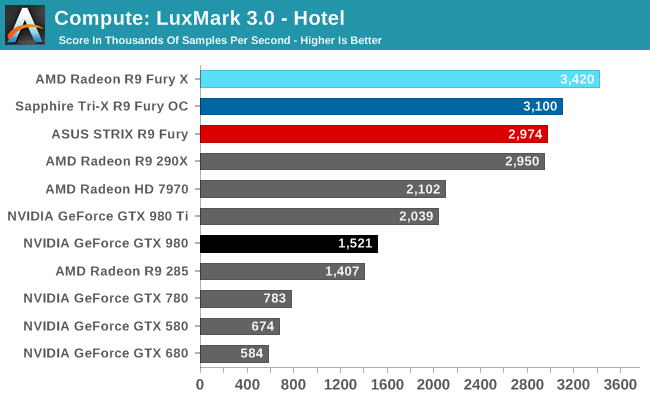
For LuxMark with the R9 Fury X already holding the top spot, the R9 Fury cards easily take the next two spots. One interesting artifact of this is that the R9 Fury’s advantage over the GTX 980 is actually greater than the R9 Fury X’s over the GTX 980 Ti’s, both on an absolute and relative basis. This despite the fact that the R9 Fury is some 13% slower than its fully enabled sibling.
For our second set of compute benchmarks we have CompuBench 1.5, the successor to CLBenchmark. CompuBench offers a wide array of different practical compute workloads, and we’ve decided to focus on face detection, optical flow modeling, and particle simulations.
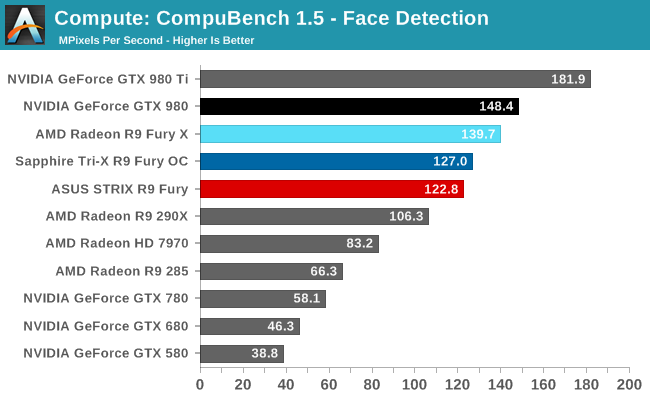
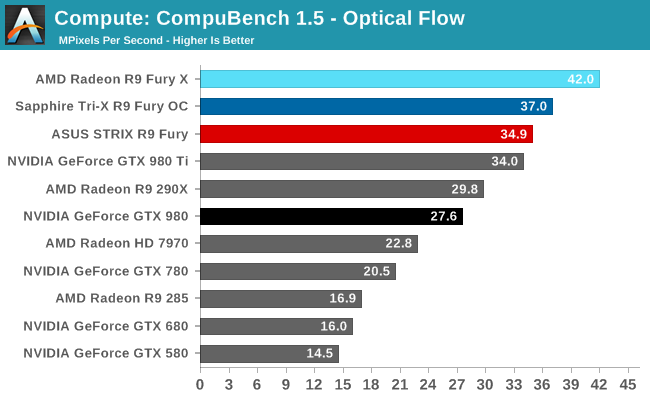
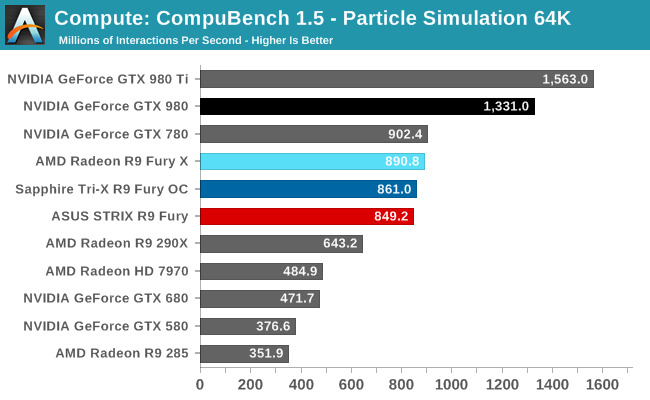
Not unlike LuxMark, tests where the R9 Fury X did well have the R9 Fury doing well too, particularly the optical flow sub-benchmark. The drop-off in that benchmark and face detection is about what we’d expect for losing 1/8th of Fiji’s CUs. On the other hand the particle simulation benchmark is hardly fazed beyond the clockspeed drop, indicating that the bottleneck lies elsewhere.
Our 3rd compute benchmark is Sony Vegas Pro 13, an OpenGL and OpenCL video editing and authoring package. Vegas can use GPUs in a few different ways, the primary uses being to accelerate the video effects and compositing process itself, and in the video encoding step. With video encoding being increasingly offloaded to dedicated DSPs these days we’re focusing on the editing and compositing process, rendering to a low CPU overhead format (XDCAM EX). This specific test comes from Sony, and measures how long it takes to render a video.
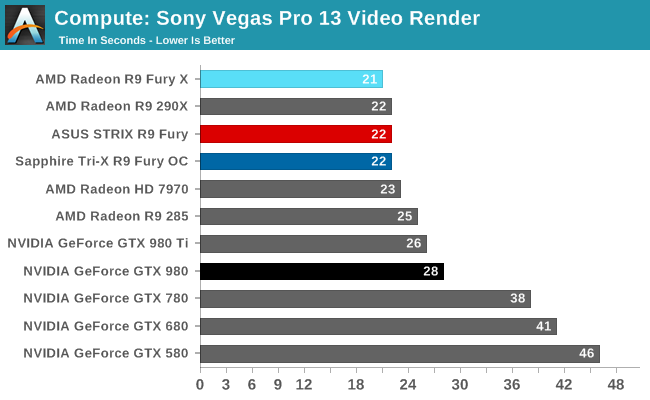
At this point Vegas is becoming increasingly CPU-bound and will be due for replacement. The R9 Fury comes in one second behind the chart-topping R9 Fury X, at 22 seconds.
Moving on, our 4th compute benchmark is FAHBench, the official Folding @ Home benchmark. Folding @ Home is the popular Stanford-backed research and distributed computing initiative that has work distributed to millions of volunteer computers over the internet, each of which is responsible for a tiny slice of a protein folding simulation. FAHBench can test both single precision and double precision floating point performance, with single precision being the most useful metric for most consumer cards due to their low double precision performance. Each precision has two modes, explicit and implicit, the difference being whether water atoms are included in the simulation, which adds quite a bit of work and overhead. This is another OpenCL test, utilizing the OpenCL path for FAHCore 17.
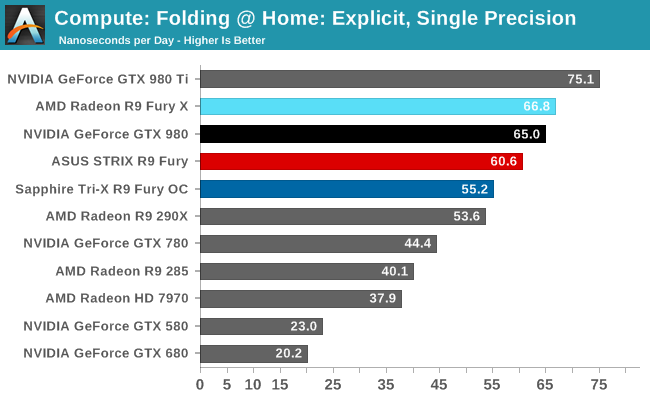
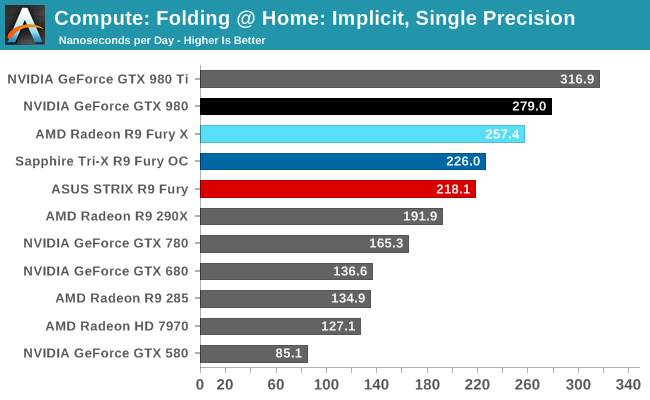
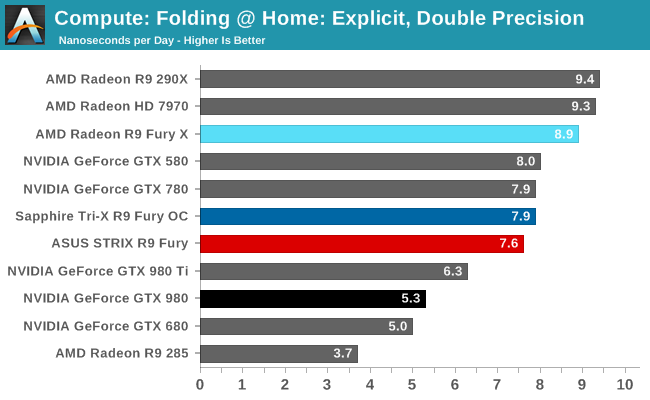
Overall while the R9 Fury doesn’t have to aim quite as high given its weaker GTX 980 competition, FAHBench still stresses the Radeon cards. Under single precision tests the GTX 980 pulls ahead, only surpassed under double precision thanks to NVIDIA’s weaker FP64 performance.
Wrapping things up, our final compute benchmark is an in-house project developed by our very own Dr. Ian Cutress. SystemCompute is our first C++ AMP benchmark, utilizing Microsoft’s simple C++ extensions to allow the easy use of GPU computing in C++ programs. SystemCompute in turn is a collection of benchmarks for several different fundamental compute algorithms, with the final score represented in points. DirectCompute is the compute backend for C++ AMP on Windows, so this forms our other DirectCompute test.
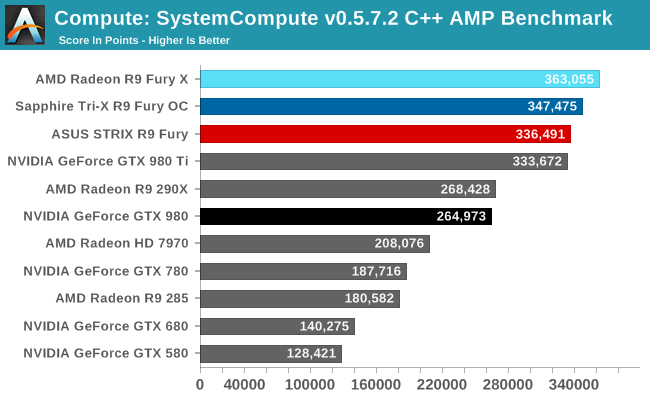
As with our other tests the R9 Fury loses some performance on our C++ AMP benchmark relative to the R9 Fury X, but only around 8%. As a result it’s competitive with the GTX 980 Ti here, blowing well past the GTX 980.










288 Comments
View All Comments
Shadow7037932 - Friday, July 10, 2015 - link
Yes! Been waiting for this review for a while.Drumsticks - Friday, July 10, 2015 - link
Indeed! Good that it came out so early too :DI'm curious @anandtech in general, given the likely newer state of the city/X's drivers, do you think that the performance deltas between each fury card and the respective nvidia will swing further or into AMD's favor as they solidify their drivers?
Samus - Friday, July 10, 2015 - link
So basically if you have $500 to spend on a video card, get the Fury, if you have $600, get the 980 Ti. Unless you want something liquid cooled/quiet, then the Fury X could be an attractive albeit slower option.Driver optimizations will only make the Fury better in the long run as well, since the 980Ti (Maxwell 2) drivers are already well optimized as it is a pretty mature architecture.
I find it astonishing you can hack off 15% of a cards resources and only lose 6% performance. AMD clearly has a very good (but power hungry) architecture here.
witeken - Friday, July 10, 2015 - link
No, not at all. You must look at it the other way around: Fury X has 15% more resources, but is <<15% faster.0razor1 - Friday, July 10, 2015 - link
Smart , you :) :D This thing is clearly not balanced. That's all there is to it. I'd say x for the WC at 100$ more make prime logic.thomascheng - Saturday, July 11, 2015 - link
Balance is not very conclusive. There are games that take advantage of the higher resources and blows past the 980Ti and there are games that don't and therefore slower. Most likely due to developers not having access to Fury and it's resources before. I would say, no games uses that many shading units and you won't see a benefit until games do. The same with HBM.FlushedBubblyJock - Wednesday, July 15, 2015 - link
What a pathetic excuse, apologists for amd are so sad.AMD got it wrong, and the proof is already evident.
No, NONE OF US can expect anandtech to be honest about that, nor it's myriad of amd fanboys,
but we can all be absolutely certain that if it was nVidia whom had done it, a full 2 pages would be dedicated to their massive mistake.
I've seen it a dozen times here over ten years.
When will you excuse lie artists ever face reality and stop insulting everyone else with AMD marketing wet dreams coming out of your keyboards ?
Will you ever ?
redraider89 - Monday, July 20, 2015 - link
And you are not an nividia fanboy are you? Hypocrite.redraider89 - Monday, July 20, 2015 - link
Typical fanboy, ignore the points and go straight to name calling. No, you are the one people shold be sad about, delusional that they are not a fanboy when they are.redraider89 - Monday, July 20, 2015 - link
Proof that intel and nvidia wackos are the worst type of people, arrogant, snide, insulting, childish. You are the poster boy for an intel/nvidia sophomoric fanboy.